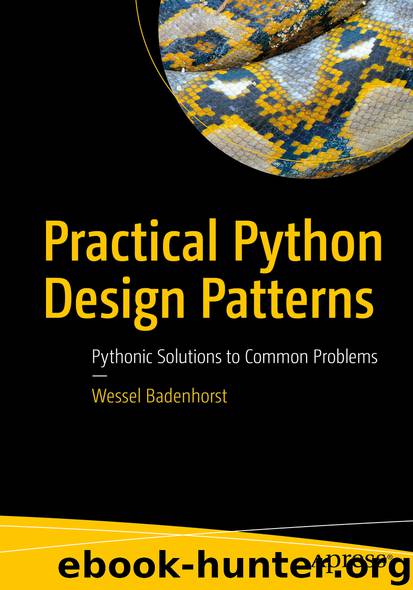Practical Python Design Patterns by Wessel Badenhorst

Author:Wessel Badenhorst
Language: eng
Format: epub, mobi
Publisher: Apress, Berkeley, CA
main_function(hd, "1221345439")
Already it is clear that we have a much cleaner solution at hand. We did not have to make any changes to the way each class is connected to the next, and apart from passing on the request, we did not require any changes to be made to the individual execute functions or the main function in order to accommodate the way each class executes the request. We have clearly separated each function into its own unit of code that can be plugged into, or removed from, the chain of classes dealing with the request.
Each handler cares only about its own execution and ignores what happens when another handler executes because of the query. The handler decides in the moment if it should do anything as a result of the request it receives, which leads to increased flexibility in determining which handlers should execute as a result of a query. The best part of this implementation is that handlers can be added and removed at runtime, and when the order is unimportant in terms of the execution queue, you could even shuffle the order of the handlers. This only goes to show, once again, that loosely coupled code is more flexible than tightly coupled code.
To further illustrate this flexibility, we extend the previous program so each class will only do something if it sees that the digit associated with the class name is in the request string.
class CatchAll(object):
def __init__(self):
self.next_to_execute = None
Download
Practical Python Design Patterns by Wessel Badenhorst.mobi
This site does not store any files on its server. We only index and link to content provided by other sites. Please contact the content providers to delete copyright contents if any and email us, we'll remove relevant links or contents immediately.
The Mikado Method by Ola Ellnestam Daniel Brolund(20603)
Hello! Python by Anthony Briggs(19898)
Secrets of the JavaScript Ninja by John Resig Bear Bibeault(18206)
Dependency Injection in .NET by Mark Seemann(18107)
The Well-Grounded Java Developer by Benjamin J. Evans Martijn Verburg(17575)
OCA Java SE 8 Programmer I Certification Guide by Mala Gupta(17420)
Kotlin in Action by Dmitry Jemerov(17183)
Adobe Camera Raw For Digital Photographers Only by Rob Sheppard(16930)
Algorithms of the Intelligent Web by Haralambos Marmanis;Dmitry Babenko(16234)
Grails in Action by Glen Smith Peter Ledbrook(15388)
Test-Driven iOS Development with Swift 4 by Dominik Hauser(10392)
Becoming a Dynamics 365 Finance and Supply Chain Solution Architect by Brent Dawson(8053)
Microservices with Go by Alexander Shuiskov(7818)
Practical Design Patterns for Java Developers by Miroslav Wengner(7718)
Test Automation Engineering Handbook by Manikandan Sambamurthy(7670)
Angular Projects - Third Edition by Aristeidis Bampakos(7159)
The Art of Crafting User Stories by The Art of Crafting User Stories(6611)
NetSuite for Consultants - Second Edition by Peter Ries(6531)
Demystifying Cryptography with OpenSSL 3.0 by Alexei Khlebnikov(6305)
